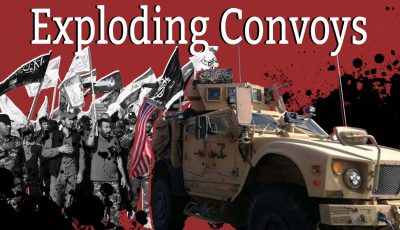Video: US Is Preparing Military Response to Wave of Iranian-backed Attacks on Its Forces in Iraq

Over the past months, attacks on convoys of the US-led coalition moving military equipment and supplies have become an ordinary development in Iraq. Local Iranian-backed resistance groups demanding a US military withdrawal from the country have conducted over two dozen attacks so far. The most recent ones took place on September 22 and 23.
The September 22 attack erupted in the district of al-Dujayl, around 60 km to the north of Baghdad. According to Iraq’s Security Media Cell, the convoy was targeted with an improvised explosive device. No casualties were reported. On the afternoon of September 23, a second supply convoy of the U.S.-led coalition was targeted in the district of Awja, more than 160 km north of Baghdad.
The Islamic Resistance in Iraq (also known as Ashab al-Kahf) claimed responsibility for the September 23 incident saying that several military vehicles belonging to British forces were damaged. Meanwhile, another group, the Breaker of Titans Company (Saryat Qasim al-Jabbarin), said that it had attacked coalition convoys near the town of Hillah in Babylon province and in the district of Abu Ghraib west of Baghdad. In an official statement, the group claimed that it will continue attacks until U.S. forces are expelled from Iraq.
While regular attacks on supply convoys of the Coalition cause apparent media jitters, they have not caused any notable damage to the coalition forces themselves. Logistical and supply convoys are often operated by private military contractors and local forces affiliated with or just hired by the coalition.
The US military still has a strong presence at its fortified positions and remaining bases in central and northern Iraq. This year the Pentagon even reinforced the security of its forces by deploying Patriot surface-to-air missile and C-RAM (counter rocket, artillery, and mortar) systems. The C-RAM is now regularly employed to protect the US embassy area in Baghdad’s Green Zone from rocket strikes.
The US military has been also conducting active reconnaissance and electronic warfare operations to detect and suppress infrastructure of Iranian-backed forces working against its interests in the region. On September 24, a U.S. EC-130H Compass Call “electronic attack” aircraft was spotted over the southern and eastern regions of Iraq. The aircraft took off on September 24 from the Al Dhafra Air Base in the UAE’s capital, Abu Dhabi. After crossing the Persian Gulf, the aircraft entered Iraq’s airspace and flew between the southern province of Basrah and the eastern city of Kut in a line parallel to the Iraqi-Iranian border.
The Compass Call is a heavily modified version of the C-130 Hercules developed to disrupt enemy command and control communications, perform offensive counter-information operations and carry out other kinds of electronic attacks. The U.S. Air Force’s EC-130Hs carry out missions over the Persian Gulf on a regular basis. Nevertheless, previously they rarely flew over Iraq.
Pro-Iranian sources claim that the increased US military and intelligence activity near Iranian borders are an indication of the US-Israeli preparations for aggressive actions in Iran. Despite this, in the current conditions, an open Iranian-US conflict in the Persian Gulf region in the near future remains an unlikely scenario. At the same time, the proxy conflict between Iranian-led forces and the US-Israeli-led bloc have been escalating.
*
Note to readers: please click the share buttons above or below. Forward this article to your email lists. Crosspost on your blog site, internet forums. etc.
SUPPORT SOUTHFRONT:
PayPal: [email protected], http://southfront.org/donate/ or via: https://www.patreon.com/southfront

